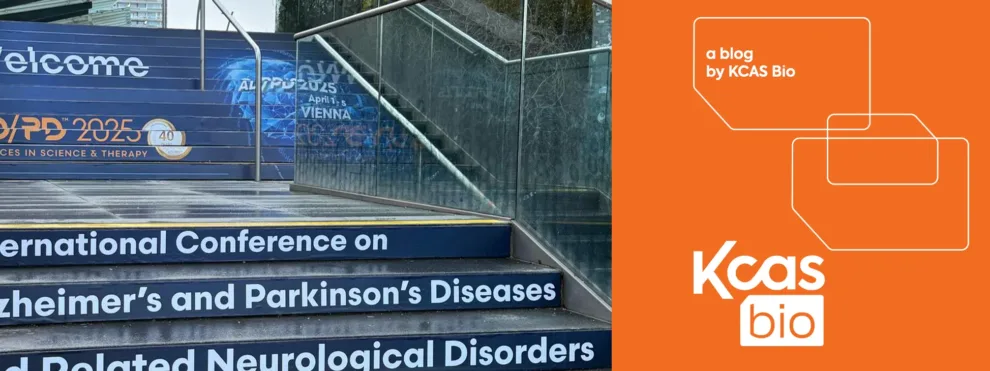We were happy to participate in the AD/PD™ 2025 International Conference on Alzheimer’s and Parkinson’s Diseases and related neurological disorders, held from April 1 to 5, 2025, in Vienna, Austria. The conference was a valuable opportunity to connect with experts, share our experience, and gain insights into emerging trends and advances in neurodegenerative research and drug development. We’re excited to share our feedback and key takeaways from the event in this blog.
Evolving Pipelines and Biomarkers in Alzheimer’s Disease Drug Development
In 2024, the Alzheimer’s disease (AD) drug development pipeline continued its upward trend, with 182 active clinical trials for 128 unique drugs. Of these, 74% are disease-targeted treatments, aimed not only at the classical hallmarks of AD, but more prominently at alternative pathways, such as neuroinflammation (e.g., TREM2-targeting with the VG 3927 small molecule [1] or the VHB937 antibody), synaptic plasticity, and autophagy.
Combination therapies are also emerging, such as Eisai’s Phase 2 trial in early AD, which combines E2814 (an anti-MTBR Tau antibody) with Lecanemab (an anti-Aβ treatment) to target multiple pathogenic pathways.
There’s increasing interest in repurposed drugs [2], which already have established safety profiles and offer a faster route to potential AD treatments, among them, GLP-1 receptor agonists, originally approved for diabetes and obesity [3].
Blood Biomarkers for AD Diagnosis
There is growing momentum to integrate blood-based biomarkers into clinical practice. They offer great promise in advancing diagnostics, but the path remains fraught with challenges. These include pre-analytical and analytical standardization, the need for real-world data across diverse demographics, and the impact of confounding factors and comorbidities (e.g., elevated pTau217 and pTau181 in individuals with chronic kidney disease) [4].
Biomarkers of current interest for diagnostic purposes include:
- pTau217 and the pTau217/Aβ-42 ratio, applied with a dual cut-off approach to increase both negative predictive value (NPV) and positive predictive value (PPV)
- Synaptic biomarkers, which are emerging as sensitive indicators of synaptic dysfunction in AD
Biomarkers For Other Neurodegenerative Diseases
While biomarker discovery is also making strides in non-Alzheimer’s neurodegenerative diseases, such as Parkinson’s Disease (PD) and Dementia with Lewy Bodies (DLB), the corresponding drug development pipelines remain comparatively limited, with only 10 active clinical trials in Dementia with Lewy Bodies (DLB). One example of these emerging biomarkers is DOPA Decarboxylase (DDC), which is elevated in the CSF of patients with PD, DLB, and AD with Lewy body co-pathology [5], and also increases in the plasma of PD patients, though only following dopaminergic treatment [6].
Finally, a promising approach that emerged a few years ago to address the challenge of developing a quantitative method for measuring pathological neurotoxic proteins is the detection of cryptic peptides. These peptides are produced as a result of TDP-43 loss-of-function and can be found in the CSF of patients with Amyotrophic Lateral Sclerosis (ALS) and Frontotemporal Dementia (FTD) [7,8].
Meeting Evolving Needs In Biomarker Method Development
We had valuable discussions with sponsors and researchers at our booth about biomarker method readiness and development needs. Most of our biomarker assays are validated based on their Context of Use (CoU) within specific clinical development studies or programs. For example, our NfL assay on SIMOA is extensively validated and typically only requires confirmation that the working range aligns with the sponsor’s intended application. For other biomarkers, especially in exploratory settings, we might need to evaluate methods for critical parameters such as parallelism (or selectivity) and the minimum required dilution for the pathology of interest.
For those seeking an LBA-based method to measure pathological alpha-synuclein, we currently don’t have one. This remains a high-interest area, and we are actively monitoring the availability of reliable commercial kits. If you’re interested in developing one, our method development team is ready to collaborate.
Exploring Innovative Platforms And Strategic Partnerships
We took this opportunity to explore innovative platforms such as O-Link, Spearbio, and NULISA, which offer multiplexed, highly sensitive biomarker panels for neurological and inflammatory diseases.
Additionally, we had a great exchange with ADx Neurosciences, now part of Fujirebio, regarding their pipeline of innovative biomarker assays on the Lumipulse G1200 platform. These discussions also highlighted the importance of actively proposing new tests for emerging biomarkers to ensure we stay aligned with the latest scientific discoveries and evolving drug development needs.
AD/PD 2025 reinforced our commitment to advancing neurodegenerative disease research and drug development through robust bioanalytical solutions. We’re looking forward to the exciting collaborations and discoveries to come.

